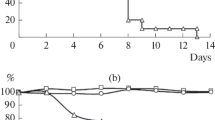Summary
After covalent attachment of bacterial lipopolysaccharide to the nucleoprotein of influenza A virus, this water-soluble antigen could be incorporated firmly into ISCOM. This potent “immunostimulating complex” induced the production of high antibody titers in mice and could partially protect the animals from a lethal challenge infection. After immunization with ISCOM preparations NP-specific cytotoxic T cell activity could not be demonstrated.
Similar content being viewed by others
References
Andersson J, Melchers F, Galanos C, Lüderitz O (1973) The mitogenic effect of Lipopolysaccharide on bone marrow-derived mouse lymphocytes. Lipid A as the mitogenic part of the molecules. J Exp Med 137: 943–953
Andrew ME, Coupar BEH (1988) Efficacy of influenza hemagglutinin and nucleoprotein as protective antigens against influenza virus infections in mice. Scand J Immunol 28: 81–85
Becht H, Malole B (1975) Comparative evaluation of different fixation procedures and different coupling reagents for the demonstration of influenza virus-specific antibodies by the indirect hemagglutination test. Med Microbiol Immunol 162: 43–53
Burnette WN (1981) “Western blotting”: electrophoretic transfer of proteins from sodium dodecyl sulfate-polyacrylamide gels to unmodified nitrocellulose and radiographic detection with antibody and radioiodinated protein A. Anal Biochem 112: 195–203
De Vries P, van Binnendijk R, van der Marel P, van Wezel A, Voorma H, Sundquist B, Uytdehaag F, Osterhaus A (1988) Measles virus fusion protein presented in an immune-stimulating complex (ISCOM) induces haemolysis-inhibiting and fusion-inhibiting antibodies, virus-specific T cells and protection in mice. J Gen Virol 69: 549–559
Deres K, Schild H, Wiesmüller KH, Jung G, Rammensee HG (1989) In vivo priming of virus-specific cytotoxic T lymphocytes with synthetic lipopeptide vaccine. Nature 342: 561–564
Gammelin M, Mandler J, Scholtissek C (1989) Two subtypes of nucleoproteins (NP) of influenza A viruses. Virology 169: 71–80
Howard CR, Sundquist B, Allan J, Brown SE, Chen SH, Morein B (1987) Preparation and properties of immune-stimulating complexes containing hepatitis B virus surface antigen. J Gen Virol 68: 2281–2289
Kapitany RA, Zeborowsky EJ (1973) A high resolution PAS stain for polyacrylamide gel electrophoresis. Anal Biochem 56: 361–369
Laemmli UK (1970) Cleavage of structural proteins during the assembly of the head of bacteriophage T4. Nature 227: 680–685
Lin YL, Askonas BA (1981) Biological properties of an influenza A virus-specific killer T-cell clone. J Exp Med 154: 225–234
Lowry OH, Rosebrough NJ, Farr AL, Randall RG (1951) Protein measurement with the Folin phenol reagent. J Biol Chem 193: 265–275
Lukacher AE, Braciale VL, Braciale TJ (1984) In vivo effector function of influenza virus-specific cytotoxic T-lymphocyte clones is highly specific. J Exp Med 160: 814–826
Mandler J, Scholtissek C (1989) Localization of the temperature-sensitive defect in the nucleoprotein of an influenza A/FPV/Rostock/34 virus. Virus Res 12: 113 (GenBank Acc. Nr. M 24456)
Morein B (1988) The ISCOM antigen-presenting system. Nature 332: 287–288
Morein B, Belak S, Soos T, Rusvai M, McGwire B, Bognar K (1989) ISCOM of viral envelope proteins protects against Aujeszky's disease. Vet Microbiol 20: 143–154
Morein B, Lövgren K, Höglund S, Sundquist B (1987) The ISCOM: an immunostimulating complex. Immunol Today 8: 333–338
Morein B, Sundquist B, Hoglund S, Dalsgaard K, Osterhaus A (1984) Iscom, a novel structure for antigenic presentation of membrane proteins from enveloped viruses. Nature 308: 457–459
Nakane PK, Kawaoi A (1974) Peroxidase labeled antibody. A new method of conjugation. J Histochem Cytochem 22: 1084–1091
Osterhaus A, Weyer K, Uytdehaag F, Jarrett D, Sundquist B, Morein B (1985) Induction of protective immune response in cats by vaccination with feline leukemia virus ISCOM. J Immunol 135: 591–596
Peavy DL, Adler WH (1970) The mitogenic effects of endotoxin and staphylococcal enterotoxin B on mouse spleen cells and human peripheral lymphocytes. J Immunol 105: 1453–1458
Stitz L, Huang RTC, Hengartner H, Rott R, Zinkernagel R (1985) Cytotoxic T cell lysis of target cells fused with liposomes containing influenza hemagglutinin and neuraminidase. J Gen Virol 66: 1333–1339
Stitz L, Schmitz C, Binder D, Zinkernagel R, Paoletti E, Becht H (1990) Characterization and immunological properties of influenza A virus nucleoprotein (NP): cell-associated NP isolated from infected cells or viral NP expressed by vaccinia recombinant virus do not confer protection. J Gen Virol 71: 1169–1179
Townsend A, Bodman H (1989) Antigen recognition by class I-restricted T-lymphocytes. Annu Rev Immunol 7: 601–624
Virelizier JL, Allison AC, Oxford JS, Schild GC (1977) Early presence of ribonucleoprotein antigen on surface of influenza virus-infected cells. Nature 266: 52–54
Wahren B, Nordlund S, Akesson A, Sundqvist V-A, Morein B (1987) Monocyte and ISCOM enhancement of cell-mediated response to cytomegalovirus. Med Microbiol Immunol 176: 13–19
Wraith DC (1987) The recognition of influenza A virus-infected cells by cytotoxic T-lymphocytes. Immunol Today 8: 239–246
Wraith DC, Vessey AE, Askonas BA (1987) Purified influenza virus nucleoprotein protects mice from lethal infection. J Gen Virol 68: 433–440
Author information
Authors and Affiliations
Rights and permissions
About this article
Cite this article
Weiß, H.P., Stitz, L. & Becht, H. Immunogenic properties of ISCOM prepared with influenza virus nucleoprotein. Archives of Virology 114, 109–120 (1990). https://doi.org/10.1007/BF01311015
Received:
Accepted:
Issue Date:
DOI: https://doi.org/10.1007/BF01311015




